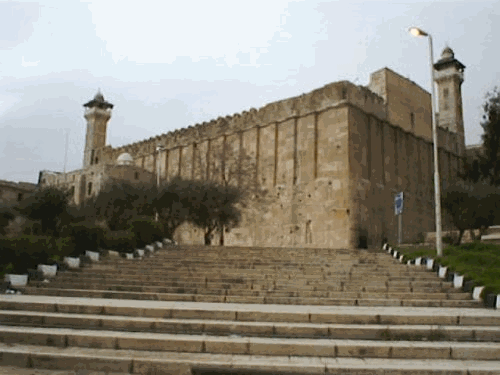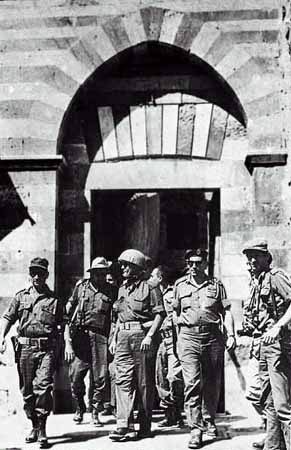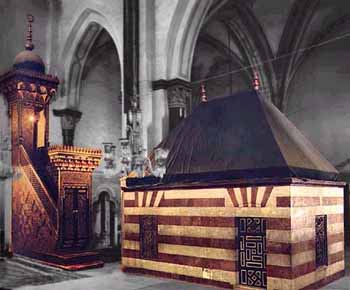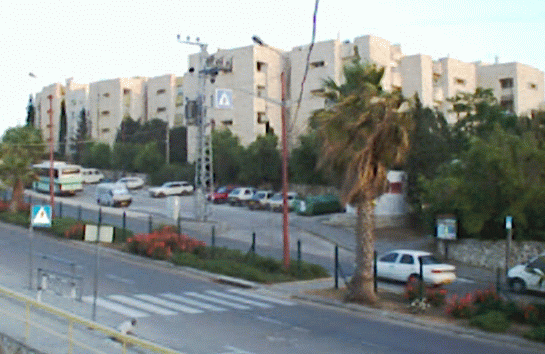Tomb of the Patriarchs
 |
Like Jerusalem, 23
miles to its north, the ancient city of Hebron stirs deep religious and political passions, and has been the scene of
heightened tension between Jews and Arabs for much of the last century.
Hebron is revered as one of the four holiest places in Judaism (along
with Jerusalem, Safed and Tiberias) and Jews
had lived continouslythere for centuries until the small community was forced out after brutal massacres led by Arab residents in the early 20th century. After Israel recaptured the West Bank during the Six Day War in 1967, a number of Jewish families reestablished the community near the ancient Tomb of the Patriachs.
As part of various peace agreements with the Palestinians, the Israeli government has withdrawn its presence from the majority of the city and now allows it to be administered by the Palestinian Authority.
Though the site of conflict during the Palestinian War from 2000 to 2005, the Jewish area of Hebron is now relatively safe and tourists are free to visit the community and the Jewish biblical sites under the guarding eye of the Israel Defense Forces.
History
The Hebrew word "Hebron" is derived from the Hebrew
word for "friend" (haver), a description for the Patriarch Abraham,
who was considered to be the friend of God. The Arabic "Al- Khalil"
— literally "the friend" — has a nearly identical derivation,
and also refers to the Patriarch Abraham (Ibrahim), whom Muslims similarly
describe as the friend of God.
Hebron, which
rises 3,050 feet (926 meters) above sea level, has a long and rich Jewish
history. It was one of the first places where the Patriarch Abraham resided after his arrival in Canaan. King David was anointed in Hebron, where he reigned for seven years.
One thousand years later, during the first Jewish
revolt against the Romans,
the city was the scene of extensive fighting. Jews lived in Hebron almost
continuously throughout the Byzantine, Arab, Mameluke and Ottoman periods.
It was only in 1929 — as a result of a murderous
Arab pogrom in which 67 Jews were murdered and the remainder were
forced to flee — that the city became temporarily "free" of
Jews.
Following the creation
of the State of Israel in 1948, and the invasion by Arab armies, Hebron was captured and occupied by the Jordanian Arab Legion. During the
Jordanian occupation, which lasted until 1967, Jews were not permitted to
live in the city, nor -- despite the Armistice
Agreement -- to visit or pray at the Jewish holy sites in the city.
Additionally, the Jordanian authorities and local residents undertook a
systematic campaign to eliminate any evidence of the Jewish presence in the
city. They razed the Jewish Quarter, desecrated the Jewish cemetery and
built an animal pen on the ruins of the Avraham Avinu synagogue.
Minister of Defense, Moshe Dayan, Commander of the
Central Command, Uzi Narkis, and Gen. Rechavam Ze'evi visiting the gate
of the Tomb of the Patriarchs (WZO)
 |
After the 1967
Six-Day War, the Jewish community of Hebron was re-established. On April 4, 1968, a group of Jews registered at the
Park Hotel in the city. The next day they announced that they had come to
re- establish Hebron's Jewish community. The actions sparked a nationwide
debate and drew support from across the political spectrum. After an
initial period of deliberation, Prime Minister Levi
Eshkol's Labor-led government decided to temporarily move the group
into a near-by IDF compound, while a new community -- to be called Kiryat
Arba -- was built adjacent to Hebron.
The first 105 housing units were ready in the autumn of 1972.
The Jewish community in Hebron itself was re-established
permanently in April 1979, when a group of Jews from Kiryat
Arba moved into Beit
Hadassah. Following a deadly terrorist attack in May 1980 in which six
Jews returning from prayers at the Tomb
of the Patriarchs were murdered, and 20 wounded, Prime Minister Menachem
Begin's Likud-led government agreed to refurbish Beit
Hadassah, and to permit Jews to move into the adjacent Beit Chason and
Beit Schneerson buildings in the old Jewish Quarter. An additional floor
was built on Beit Hadassah,
and 11 families moved in during 1986. Over the last two decades, many other
Jewish properties and buildings in Hebron have been refurbished and rebuilt.
Religious Significance
The Cave of Machpelah, or Tomb
of the Patriarchs, is the world's most ancient Jewish site
and the second holiest place for the Jewish people, after the Temple
Mount in Jerusalem. The
cave was purchased by Abraham as a burial place for his wife Sarah some 3,700 years ago, along with the trees and field adjoining it, the
first recorded transaction of a Hebrew buying land in Canaan (Genesis
23). Abraham, Isaac, Jacob, Rebecca, and Leah were all later buried in the same place. These are considered the patriarchs
and matriarchs of the Jewish people. The only one who is missing is Rachel,
who was buried near Bethlehem where she died in childbirth. Muslims believe that Joseph is also buried here, though Jews think he was buried in Nablus.
The building covering the cave was constructed roughly
two thousand years ago by Herod.
The 40-60 foot high walls are similar to those of the Temple
Mount. Since Herod's time, the structure has been used by foreign
conquerors as a shrine to their own religions. Thus, the Byzantines and Crusaders transformed
it into a church and the Muslims converted it a mosque. About 700 years ago, the Mamelukes conquered Hebron, declared
the structure a mosque and forbade entry to Jews, who were not allowed
past the seventh step on a staircase outside the building.
The tomb of Isaac (WZO)
 |
The structure is divided into three rooms: Ohel Avraham, Ohel
Yitzhak, and Ohel Ya'akov. Presently Jews have access to Ohel Yitzhak,
the largest room, only 10 days a year. The tombs are all underground.
The visible parts are covered with tapestries and cenotaphs. A 700-year-old
stained-glass window adorns the tomb of Jacob and Leah, which are in an adjoining
courtyard opposite the monuments to Abraham and Sarah.
Hebron contains several other sites of Jewish religious and historical significance,
including the Tombs of Othniel Ben Kenaz (the first Judge of Israel) and
Avner Ben Ner (general and confidante to Kings Saul and David), and Ruth and Jesse
(great-grandmother and father, respectively, of King David). Victims of
the 1929 pogrom, as well as prominent rabbinical sages and community figures,
are buried in Hebron's ancient Jewish cemetery.
In recent years, Hebron has been the site of many
violent incidents, two of which stand out. In May 1980, Palestinian
terrorists murdered six Jewish yeshiva students and wounded 20 others, who
were returning from prayers at the Tomb
of the Patriarchs. In February 1994, a Jew named Baruch Goldstein
opened fire on Muslim worshippers at the Tomb, killing 29 and wounding 125.
Hebron Today
Hebron is
home to approximately 120,000 Arabs, 500 Jews and a handful of Christians.
On the outskirts of the city are glass-blowing, pottery and woodworking
shops and, near the center of town, a large visitor center. The Arab market
is similar to those elsewhere, but given the volatility of the city,
visitors are usually discouraged from going there. The city also has a
small museum of artifacts used in the area through the centuries.
Though Israel regained control of Hebron in 1967, the Cave of Machpelah has remained under the authority of the Muslim Waqf (Religious Trust),
which continues to restrict Jewish access. No visitors are allowed inside
during Muslim prayer times, Fridays or Muslim holidays.
Following the signing of the Interim
Agreement on September 28, 1995, authority over most civilian matters
concerning Hebron's Arab residents was transferred from the IDF Civil
Administration to the Palestinian
Authority and/or the (Arab) Municipality of Hebron. Those services
which remained the responsibility of the Civil Administration were
transferred to the Palestinian
Authority and the Municipality following the IDF redeployment in Hebron in 1997.
Since then, the Palestinians have controlled roughly 80 percent of the city
and Israel 20 percent (including the area where Jews are living).
International observers patrol the city to help monitor the situation.
 |
At
the time of Abraham, the Canaanite town in this place was known as Kiryat
Arba. The name was later changed to Hebron (Joshua
14:15). Today, Kiryat Arba is the name of a suburb of Hebron, five
minutes from the Cave of
Machpelah and the heart of the city. Established in 1971, Kiryat Arba
was the first renewed Jewish community in Judea and Samaria. Today, Kiryat
Arba is home to more than 6,000 Jews who have a reputation for being among
the most zealous defenders of the idea that Jews have a right to live in
the West Bank. The town has educational institutions from pre-nursery
school through post-High school, modern medical facilities, shopping
centers, a bank and post office.
Previous
Next
|